The sun is already above the San Bernardino Mountains in Southern California as Portor Green gets on the road and heads for his first shoeing stop of the day. The traffic inbound on I-10 toward Los Angeles is gnarled and crawling in all four lanes as Californians get their daily dose of highway gridlock along with their morning coffee.
But Green takes the ramp leading to the outbound lanes, away from Los Angeles and is soon cruising at the kind of speeds freeways were designed for.
“I like to manage my day so I’m not going in the same direction most people are,” says Green. “It makes things go a lot smoother.”
That’s also indicative of how Green approaches his horseshoeing business. He makes sure he’s running it, rather than letting it run him.
“I do almost all of my shoeing within a 50-mile circle around my home,” he explains. “There are plenty of days when I don’t drive on the freeway at all.”
Prior to starting his shoeing day, Green dropped one of his four children off at school, and then stopped by his father’s shoeing supply store. Portor is the son of Lee Green, a member of the International Horseshoeing Hall Of Fame and owner of The Shoein’ Shop, in Yucaipa. Portor is getting started a little bit later than he usually does in a day, but mentions that he’s not one of those crack-of-dawn-to-dusk shoers.
“I did do some of that when I was younger, but now I want to be able to have time with my family,” he says. “I’ll usually shoe Monday through Friday. I try to avoid the weekends. I never shoe on Sunday and will only shoe on Saturdays if I need to.”
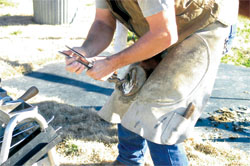
Green uses a hoof nipper as he trims a hoof. He does most of his shoeing in the Southern California high-desert country inland from Los Angeles, meaning he deals with a lot of hard, dry hooves.
In order to be able to do that and provide for his family, Green says it’s important to pay attention to how he runs his business. He stresses efficiency, professionalism and — as his day of “Shoeing For A Living” will show, wasting as little time as possible.
9:13 a.m. Green’s first stop is at a ranch where he’s scheduled to shoe two cutting horses that he describes as retired.
“I’ve been shoeing for this client for a long time, but she used to have a lot more horses,” he explains as he drives through the ranch gate. “You can see there is a lot of paddock space and training area here.”
Green says the ranch had a score or more of horses not that long ago, but now has only the pair he’s shoeing today. One belongs to the owner and the second is boarded.
Green says the ranch is fairly typical of many of the ranches he shoes at. Each of the two horses is kept in its own corral, which includes an open-sided roofed shed at one end to provide shelter from rain and the hot Southern California sun.
The hot sun won’t be a problem on this mid-January morning. It is high in the sky, but the temperature is in the low 60s at this point of the day and a sharp wind makes it seem colder. Green starts the day wearing a fleece warm up, which he’ll shed at the day grows warmer.
9:19 a.m. Green pulls his rig up close to a hitching rail, opens the doors and quickly sets up his anvil and shoeing tools before he brings the first horse out of her stall. He secures her lead rope to the rail and quickly goes to work.
There’s very little wasted motion as Green picks out the first hoof using a hoof pick to clean out the sole, then quickly pulls the shoe. He uses a wire brush to clean off more of the hoof before he goes to work with his hoof knife and nippers to trim the hoof.
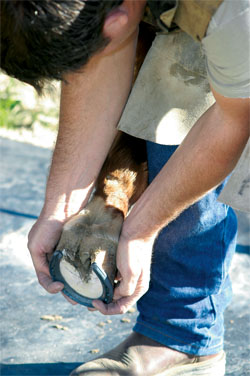
Green checks the fit of a shoe before he nails it into place. This particular horse is used for a combination of barrel racing and trail riding, so Green makes sure to fit the shoe tightly so it is less likely to be stepped off.
Green works quickly. He keeps his tools within easy reach. Once he has the hooves trimmed, he quickly goes to his truck and selects the right size shoes. He cold shapes the shoe at his anvil, checks the fit and returns for a minor adjustment, then he’s ready to nail it on.
If there’s a trademark that Green is known for, it’s his efficient nail driving. It seems that each nail is hammered home with just a few quick blows and during the course of the day, he rarely needs to bend a nail or pull one and re-drive it.
9:27 a.m. Green quickly finishes the first foot, them moves around the horse, repeating his procedure almost move-for-move on each foot. It may look mechanical, but in reality, his work involves a lot of well-drilled muscle memory.
9:43 a.m. Green says he rarely resets shoes, preferring to use new ones. And while he’s adept at hot shaping shoes, he’ll cold shape shoes that he knows only need minor adjustments to fit a horse’s feet. In the case of the horses at this ranch, the feet are so close to a particular shoe size, he believes cold shaping them saves time.
9:52 a.m. Green leads the first horse back to its corral and brings out the second one. Once again, he goes right to work on the shoeing job. There’s no one to hold the horses, but both are well-behaved — seemingly almost falling asleep as Green works on their feet.
9:57 a.m. “I spend a lot of time alone,” says Green, as he starts working on the second horse. “I don’t have anyone working with me or for me. It’s not uncommon for me not to see too many of my clients in a day.”
With both of these horses, it doesn’t appear that Green has to remove too much hoof as he does his trimming. His wire brush removes loose bits of sole and frog and he does use his hoof knife to make sure the commissures are cleaned out.
10:06 a.m. “Typically out here, I’m dealing with hard, dry feet,” Green says. “Right now, we’re doing pretty good. We had a lot or rain not too long ago. It’s starting to get pretty green now for around here.”
10:21 a.m. Green nails on the final shoe and quickly finishes the foot and he’s ready to head to his next stop. Before he does, he stops at a small shed attached to a carport. Inside, two checks are tacked to a bulletin board — one from the ranch owner, the other from her boarder. Green checks his shoeing book and on a dry erase board, writes down a day 6 weeks down the road when he’ll be back for the next shoeing.
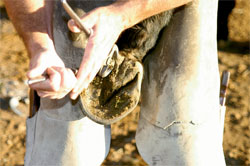
Green trims ragged edges away from a frog using his hoof nippers. This horse has had some trouble with thrush, so he’s careful to clean out the commissures with his hoof knife.
10:27 a.m. During the drive to his next stop, Green mentions that his clientele is pretty varied. He’ll shoe at big horse operations that have hundreds of horses and where plenty of other farriers also work, but he also has a number of stops where he takes care of just a few horses.
He says he’s careful to set up his schedule to minimize driving. In only about 15 minutes, he’s pulling into the driveway on his second stop of the day.
10:44 a.m. There are three horses due for shoeing and trimming at this stop. The horses are owned by a young woman named Michelle, who competes in barrel racing and also uses her horses for trail riding. Green mentions that one of the horses is new and hasn’t been broken yet. He’s trimmed her before and mentions that one of his priorities right now is to make sure that the horse becomes used to him and to having her feet trimmed.
As Green sets up his equipment, Michelle comes out from the house. She’s got some news for him. Green was scheduled to stop at her mother’s home, which is just a short distance away and trim a pony, but the pony died during the night during a severe episode of colic. Green asks Michelle to express his sympathies to her mother and they talk about the pony for a few minutes before the owner brings out the first horse, Princess, a paint with a shaggy winter coat.
Princess is the new horse that Green had mentioned. Michelle tells him she’ll stay to hold the horse, because she’s concerned that she might be a little antsy. She hasn’t had much turnout time lately.
10:58 a.m. Green goes to work trimming the feet quickly.
“Pretty comes in second here,” he explains as he works. “I’m not as concerned with getting a picture-perfect trimming job here as I am with getting the job done and getting the extra length off the hooves. I want this to be another good experience for her. That’s something we can build off in the future.”
11:18 a.m. Princess proves cooperative and Green is able to finish the trimming quickly. He then moves on to the second horse, one Michelle uses for barrel racing.
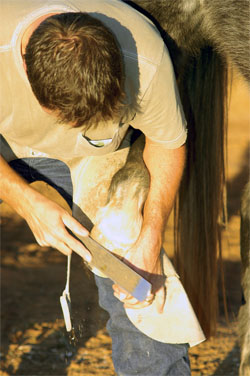
Green uses a rasp to finish a hoof. Green grew up first watching, then helping his father, International Horseshoeing Hall Of Fame member Lee Green, shoe horses and mules.
“She does trail riding with him as well, so I can’t shoe just for the arena,” Green explains. “But I will fit the shoes tightly, particularly the fronts.”
Green says the tight fit is needed for barrel racing, where a horses feet can land close together in turns. A horse could step on the edge of a shoe that had too full a fit.
11:44 a.m. The third and final horse at this stop presents certain problems, Green says. He has good quality hooves, but they’re also long and narrow. That shape becomes even more pronounced as the horse doesn’t get ridden a lot, so he doesn’t wear off as much of his own hooves. Green pulled his shoes at the end of the riding season and he’ll still go barefoot for a few more shoeing cycles. Green has to take off more hoof wall on this horse than he has from any of the other horses he’s taken car of this morning.
11:58 a.m. Green has finished up the last horse and Michelle comes back out from the house with a check for the shoeing and two trims. The two of them also agree on the next shoeing date.
Since he doesn’t have to take care of the pony belonging to Michelle’s mother, Green decides to break for an early lunch. Before he stops, he checks his voice mail and returns a call. It’s from a client whose horses he’s supposed to take care of that afternoon, who wants to check when he’ll be arriving, so she can be sure to be on hand when he does.
Green is one of those shoers who doesn’t really remember when he first started learning shoeing. Earlier, his father, Lee Green, mentioned that he often took Portor with him when he was shoeing, even when he was just a baby.
“That’s really how I taught Portor to count,” Lee recalled. “I’d have him count out the nails for me for every job.”
By Portor’s own account, it seems, “That I’ve been around shoeing forever.” He does recall that he shod his first horse all the way around, by himself, when he was 13. He was 19 in 1988 when he began shoeing full time.
Green says he was always interested in horses and shoeing, but says his own son, Tanner, 17, won’t be continuing the family tradition.
“He has no interest in it whatsoever,” Green says with a laugh. “And that’s all right.”
Green says he and his wife, Denise, have five horses of their own. They moved to a larger home relatively recently that has space for them to keep the horses at home, rather than having to board them.
Of their three daughters, Tarryn, Tiana and Tessa, Green says that two of them ride a lot and one has become active in high school rodeo.
“That’s how we’ve been spending a lot of our free time,” he says. “Putting the horses into the trailer and driving to high school rodeo events.”
Green spends a lot of time with his family. He was active as a Boy Scout leader for many years. “I’ve camped and hiked all over these mountains,” he says.
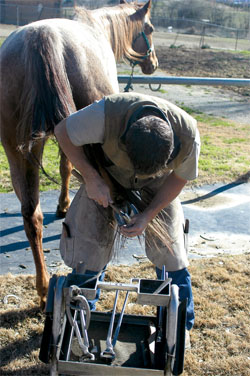
Staying low, Green nails a shoe onto a horse’s hind foot. Green’s nailing is particularly efficient. He rarely waste a nail or needs to re-drive one.
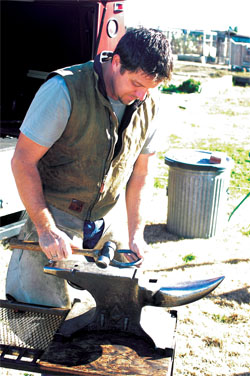
Green checks the shape of a shoe as he modifies it at his anvil. Green does a lot of cold shoeing, but takes just about every shoe to the anvil to make sure it will fit.
1:27 p.m. After lunch, Green heads to a ranch that’s located in a canyon where there are several horse properties. The one he’s headed for sprawls across a considerable number of acres and includes a main barn, an outdoor riding arena, fenced-in paddocks and a number of corrals and pens.
“I haven’t been shoeing at this place all that long,” Green mentions as he turns into the ranch’s driveway. “I started shoeing here for just one person, but I’ve been picking up a few more clients as time goes on.”
He checks in with a trainer, who gives him a list that includes two shoeing jobs and six trims. The horses are spread out in different areas of the facility, so Green decides he’ll probably move his truck several times during the stop. For the first horse — one that is to be shod — he sets up just outside one end of the main barn.
1:33 p.m. Green’s shoeing rig is a shoeing body mounted on a pickup truck. It’s well organized and has swing-up doors all around. It’s also well equipped with power tools and storage racks. The one rather unusual aspect that Green points out is an additional 90-gallon diesel tank mounted on the body above the regular, built-in tank. The two tanks are connected by a valve. When the valve is opened, gravity lets fuel from the upper tank flow into the lower one.
“I keep an eye on the price of diesel and when it’s good, I’ll fill up,” Green explains. “The odd thing is that when the valve is opened, the fuel gauge doesn’t move. A few people who were riding with me have wondered what was going on.”
1:37 p.m. “Mondays around here — and probably in most barns around the country — tend to be pretty slow,” Green says. “A lot of riders will use their horses a lot over the weekends, so Monday’s are often an off day. That makes it a good day to be shoeing. You’re out of riders’ way and they’re out of yours.”
Green says having a lot of clients at one location has its advantages. It cuts down on driving time. But big barns can also be demanding.
2:13 p.m. Green finishes the shoeing job on the first horse, then checks back with the trainer, who points out where each of the other horses needing attention are located. He climbs into his rig and drives to an area close to two of the pens.
2:17 p.m. One of the horses is a recently weaned filly, who the trainer warns him has been ornery since being separated from her mother. The trainer tends the lead rope, but the horse starts when Green begins trimming. They move her away from some of the other horses, but she’s still a handful. Green stops several times to calm her before going back to work. He manages to get the job done finally, and the filly is led away.
2:35 p.m. “I never beat on a horse or jerk them around,” he explains as he moves on to the next trim. “All it will do is make the job worse. And owners never want to see you mistreating their horse.”
2:38 p.m. Green again moves his shoeing rig, then carries his shoeing box to a run with a roofed shelter at one end where a brown gelding is stabled.
This will be the third time Green has trimmed this particular horse and he is cautious in approaching him.
“I can’t tell you just why, but this horse seems to give off bad vibes,” Green says. “He doesn’t seem comfortable with me, although he hasn’t really done anything to cause trouble.”
“This isn’t all that common for me, but for now, I’d rather do him within four walls,” Green explains. “I’m just not sure what to expect. With that young paint I just did, I knew there was probably going to be some trouble. But with this one, I just don’t know.”
Green keeps his tool box on the outside of the pen, where he can reach it easily, but where it will also be out of the way in case the horse does become rambunctious. He goes to work quickly, pausing now and then to pat the horse and murmur to him quietly.
3:04 p.m. As it turns out, all the precautions are not needed. Green is able to trim all four feet quickly as the gelding stands quietly. When he’s finished, Green removes the lead rope and steps outside the fence. The gelding actually comes over and sniffs and nuzzles him gently.
“We got along a lot better this time,” Green notes as he carries his toolbox toward a nearby pen. “Maybe he’s just getting used to me.”
Green says that while he didn’t have any problems with the gelding this time, he’s learned to trust his instincts when he’s working with horses.
“If you’ve grown up around horses and been around them all your life, you come to get an understanding of them,” he says. “You also know what can happen to you if you aren’t careful. You always want to leave yourself an out in case something does happen. I’d much rather be cautious like I was with him and have nothing happen than not be careful and have a horse blow up.”
3:07 p.m. The next horse is another gelding, a very senior horse, who requires some tender care while being handled.
“That’s all the higher this leg will go,” Green notes as he lifts one of the fronts just a couple of inches from the ground. “This leg is totally locked at the knee. I’ll have to trim him with his foot between my ankles, rather than my knees.”
Green is true to his word, trimming the hoof while he’s practically bent double. The other legs aren’t quite as stiff, but Green continues keeping the hooves as low as possible as he works.
“There’s no reason to make him any more uncomfortable that you have to,” reasons Green.
3:22 p.m. Green next moves to another trim that’s a few enclosures away. This is a young stallion, who has a reputation for feeling his oats a bit. Green ties him to the rail of his corral, shortening the lead rope more than he usually does to help keep the horse under control. Once again, he works quickly to trim and finish the feet and is done with the job long before the horse decides to make any trouble.
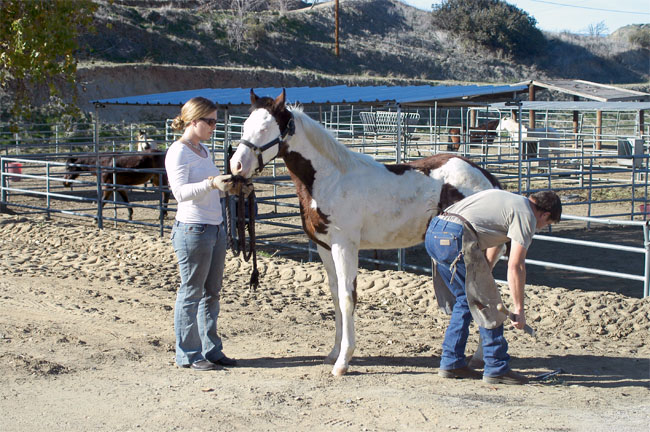
Green trims a hind hoof of a young filly as her owner holds her. Green says “pretty comes in second,” in such a case. He wants to get the job done well and quickly, so the experience won’t be a bad one for the horse.
3:39 p.m. Green still has one horse at the ranch he’s supposed to shoe, but he’s also scheduled to meet another client at 4 p.m. — and he says he’ll need the time to ensure that he can arrive on time.
“Ordinarily, I’d shoe the horse here before I go to the next appointment, but I know that my next client has rearranged her own schedule to meet me this afternoon. So I’ll come back here tomorrow morning and shoe the horse. And I won’t cash the check they gave me today until I’ve taken care of all the horses.”
4 p.m. Green reaches his next stop right on time and just a minute or two before a vehicle pulls in carrying the owners of the horses he’s supposed to see. A new stable is still under construction, but is far enough along that the horses Green is to see are housed inside.
There are three horses at the stable that Green needs to trim. Two are owned by a woman who lives at the home and the third is owned by her mother, who’s on hand for the appointment. She wants Green to pull the shoes from her horse so it can go barefoot for awhile.
4:08 p.m. In an odd sort of quirk, one of the horses at this stop has been a Green customer before – but the Green was Lee, Portor’s father. The horse is well into his 20s and was shod by Lee a number of years ago.
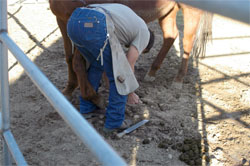
Working with an older horse, Green keeps the foot between his ankles rather than his knees as he trims it. The horse’s knee is locked, meaning it can only be raised a few inches from the ground.
All three horses are cooperative and the trimming goes quickly. Two of the horses have mild cases of thrush. Green takes extra care cleaning out the affected areas. When the owners ask for his advice on treating thrush, he mentions a couple of products that he says may be available at this father’s shop or at various tack shops throughout the area.
4:37 p.m. Green finishes up the trim on the last horse, collects his checks and goes over his calendar, writing in the next appointments for all three horses. Once that’s done, he packs up his truck and his day is done.
4:45 p.m. Green guides his truck back onto the freeway. He’s southbound now, driving in lanes that are moving freely. Just across the median, the outbound traffic from the Los Angles metropolitan area is crawling, bumper-to-bumper.
“This is how I like to wrap up my day,” Green explains. “It’s not real fancy shoeing, but it works for me and it keeps my clients happy. And I’ll be home in time to have dinner with my family.”
All in all, Portor Green has found a pretty good method of “Shoeing For A Living.”

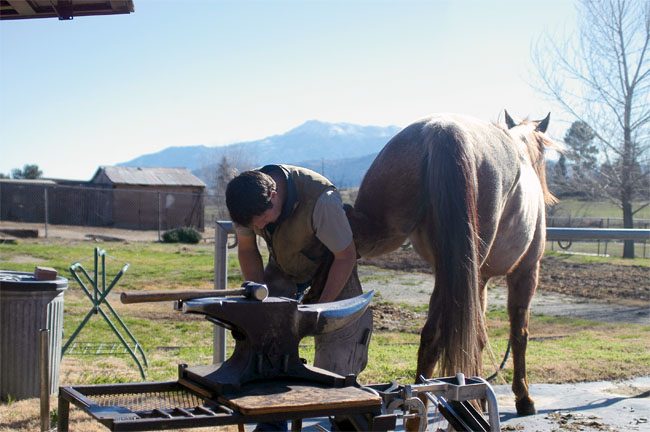
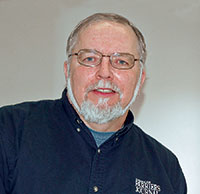






Post a comment
Report Abusive Comment